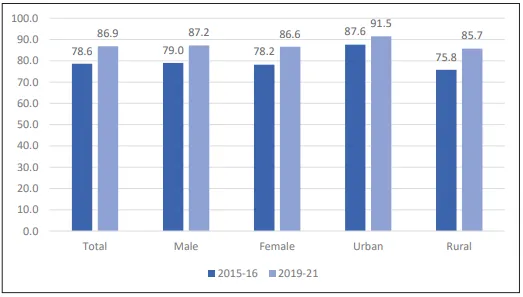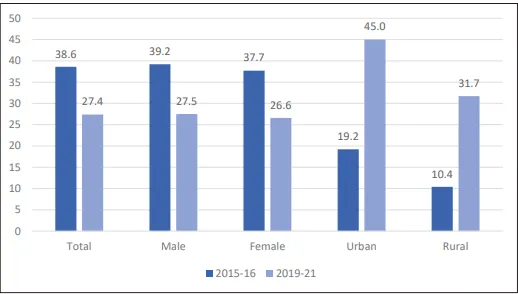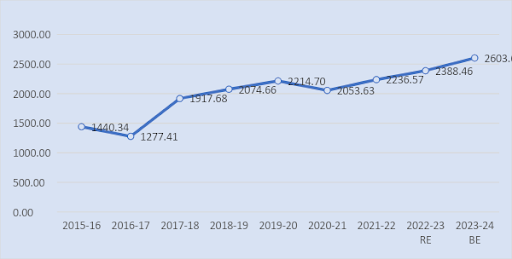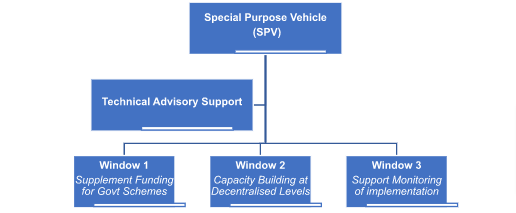-
CENTRES
Progammes & Centres
Location
 PDF Download
PDF Download 
The early years of a child’s life—particularly the first 1,000 days (or the period from a child’s birth to its second birthday)—are a critical period in its development when the brain develops faster than at any other time, laying the foundation for life-long learning, health, and well-being. In the first years of life, neurons form new connections at the astounding rate of up to 1,000 per second, and while genes provide the blueprint for the brain, a child’s environment shapes brain development.[1]
However, despite the overwhelming evidence and political momentum, over 43 percent of children under the age of five (over 250 million children) in low- and middle-income countries (LMICs) are at risk of not fulfilling their full developmental potential due to poverty and stunting. [2] Stunting and wasting [3] negatively impacts children’s physical and psycho-social well-being, including cognitive development and losses in a nation’s overall productivity and economic development. According to the World Bank,[4] a 1 percent loss in adult height because of childhood stunting results in a 1.4 percent loss in economic output.
LMICs account for one out of every 10 deaths[5] among children younger than five years from severe wasting because wasted children are more likely to die from infectious diseases. In 2020, it was estimated that an additional 6.7 million children under five would suffer from wasting due to the socioeconomic impact of the COVID-19 pandemic; 80 percent of these children would be from Sub-Saharan Africa and South Asia. [6]
Many more children are also at risk, stemming from the disruption in essential early childhood development (ECD)-related services. Between March 2020 and February 2021, an estimated 167 million pre-primary-age children in 196 countries lost early access to childhood care and education (ECCE). [7]
These COVID-19-related ECCE disruptions were estimated to result in 10.75 million additional children falling “off track” in their early development, 14.18 million grades of learning lost by adolescence, and US$308.02 billion of earnings lost in adulthood; projected developmental and learning losses were concentrated in low- and lower-middle-income countries, exacerbating long-standing global inequities. [8]
The COVID-19 pandemic and the global cost-of-living crisis threaten to reverse gains achieved in recent decades, with public budget allocations for ECD at risk. Consequently, promoting and supporting the safeguarding and expansion of financing for ECD-related services, including addressing the public financing bottlenecks hindering their equitable delivery, takes on greater urgency than ever.
Evidence shows that one of the most effective strategies for economic growth is investing in the developmental growth of at-risk young children. The short-term costs are more than offset by the immediate and long-term benefits, such as the reduced need for special education and social services, better health outcomes, lower criminal justice costs, and increased self-sufficiency and productivity among families. [9]
Investments in early education should be supported by investments in nutrition and health, as seen in a study in Burundi where every US$1 invested gave a return of at least US$19 in the most conservative scenario,[10] with the understanding that long-term effects of this on society cannot be monetised. Other studies have estimated the cost-benefit ratio of investing in nutrition to be 1:16 at a compound growth rate of 10 percent return,[11] translating into a return of US$38.6 for every dollar invested in essential nutritional interventions.
There is a need to double down on evidence-based advocacy efforts to drive policy responses at scale. This means:
The following recommendations include a detailed situation analysis for India as a case study and prescribe an implementable action plan from the G20 countries’ perspective.
The authors constructed a Child Development Index (CDI) for India using data from successive rounds of the National Family Health Survey (NFHS). The NFHS allows for individual-level data analysis, for instance, by disaggregated by age and sex or by place of residence and socioeconomic subgroups. Furthermore, the measurement of variables is consistent across time with successive rounds, space, and dimension.
The method comprises three stages. The first involves obtaining the development score for each child (aged 0-5 years). The second stage consists of aggregating the score of each indicator under its respective dimension, of which there are six (i.e., education, health and disability, nutrition, safety and security, caregiving, and household environment; see Table 1). Finally, this is followed by the aggregation of all dimensions and then defining cut-offs to identify the development status of a child. This aggregation of scores for each dimension involves two partial indices—the intensity of development and the headcount of developed children.
| Dimension | Indicator |
| Education |
|
| Health and Disability |
|
| Nutrition |
|
| Safety and Security |
|
| Caregiving |
|
| Household Environment |
|
The authors assigned equal weights to the indicators within each and across all dimensions. In other words, the summation of weights of all indicators in each dimension is equivalent to the overall weight assigned to its dimension. The authors did not include the economic domain as a dimension owing to the collinearity challenge with the household environment.
Presumptive results for the age group 0-5 years suggest that CDI has improved for both males and females and in rural and urban areas. The incremental growth on the score for males is 10.3 percent, and 10.7 percent for females. However, the authors observe a considerable jump in CDI score for rural areas (13.1 percent) compared to urban counterparts (4.5 percent).
Figure 1. Child Development Score for under-five children (by gender and place of residence)

Source: Authors’ calculation based on NFHS-4 and NFHS-5
The trends in headcount ratios of deprivation scores for 2015-16 and 2019-21 suggest improvements by 11.2 percent. The estimates by gender and place of residence indicate that 27.5 percent of males and 26.6 percent of females are deprived in 2019-21. The male-female gap declined from 1.5 percent in 2015-16 to 0.9 percent in 2019-21. Similarly, the headcount ratio of deprivation in urban areas is 10.4 percent and 31.7 percent in rural areas. Although the rural-urban gap shrunk from 25.8 percent to 21.3 percent, it remains high (see Figure 2).

Source: Authors’ calculation based on NFHS-4 and NFHS-5
The model mentioned above is developed based on suitability and feasibility in the Indian context, pending wider consultations. A comprehensive and suitable ECD monitoring framework across nations will be vital to draw comparable but contextualised milestones and benchmarks for governments to make periodic assessments and adjust programmes and policies accordingly.
Recommendation 2: Early childhood nutrition, hunger, and food security status and trend analysis
The World Food Programme declared 2022 a 'year of unprecedented hunger' due to the persistent prevalence of hunger in several regions globally. [12] It is estimated that between 702 million and 828 million people were affected by hunger in 2021; the number has grown by about 150 million since the outbreak of the COVID-19 pandemic. [13] Multiple G20 countries suffer from child malnutrition. By 2030, more than one-third of this global population will live in India. [14] Child malnutrition currently accounts for 15 percent of India's total disease burden, which costs the country around US$46 billion annually. [15]
Similarly, according to UNICEF, in 2018, nearly three in 10 children under five in Indonesia were stunted, while one in 10 were wasted.[16] South African Child Gauge (2020) estimates that about 27 percent of young children in the country are undernourished and shorter than expected due to a lack of nutritional food in early childhood. [17] Overweight children make up about 13 percent of the population in South Africa.
The G20 countries must intensify efforts to address the underlying causes of hunger and malnutrition among mothers and children. Establishing a collaborative framework for sharing scientific strategies and best practices to deal with maternal and child malnutrition is vital.
Breastfeeding, weaning, and complimentary feeding status report and gap analysis
India’s NFHS-5 reveals that the rate of exclusive breastfeeding[18] for the first six months was 55.6 percent, an improvement from the previous survey (2015-16). However, the rate of early initiation of breastfeeding (within one hour of birth) was only 41.9 percent, meaning a significant proportion of infants are not getting the benefits of colostrum (the first milk, which is rich in nutrients and antibodies).
The Indian government has several programmes and initiatives to promote and support breastfeeding, such as the Mother's Absolute Affection Programme launched in 2016,[19] Infant and Young Child Feeding Programme launched in 2008, and the National Health Mission launched in 2005. However, there is still a lack of awareness, stigma, and lack of support around breastfeeding.
The early introduction of complementary foods, poor quality of weaning foods, and lack of knowledge are common roadblocks to ensuring optimum weaning and complementary feeding. Addressing these gaps requires a multipronged approach, including awareness-raising campaigns, training of healthcare providers, robust monitoring, and supporting mothers and families.
Recommendation 4: National nutrition programmes and their effectiveness in supporting ECD status report and gap analysis
Over the past 45 years, India has implemented numerous nutrition interventions to combat malnutrition,[20] including the Integrated Child Development Services (ICDS), the Mid-Day Meal (MDM) scheme, and the National Food Security Act (2013). The Indian government has also launched several schemes, such as Poshan Abhiyaan (the flagship programme to combat malnutrition), Anganwadi Service Scheme, and the Pradhan Mantri Matru Vandana Yojana under the ICDS to improve women's and children's health. However, there are critical gaps in implementing and utilising these programmes.
According to the central government budget,[21] ICDS spending increased only marginally between 2014-15 and 2019-20. The Accountability Initiative reported that in 2019-20, the approved budgets for the Special Nutrition Programme accounted for only 44 percent of the total required amounts. The core allocation and central budget for other programmes, such as the umbrella ICDS and the MDM, have declined. There are over 30 percent vacant supervisory positions in the ICDS, while 36 percent of Poshan Abhiyaan's total expenditure is on information and communication technologies and real-time monitoring.[22] As such, most structural issues remain unresolved.
There is a need to thoroughly map the programmes and their impact on ECD, highlighting the gaps, bottlenecks, and opportunities for impact across nations to develop well-designed, well-funded, and well-implemented programmes to bridge the nutrition gaps for the most vulnerable women and children.
Recommendation 5: The role of millets, other climate-smart crops, and overall nutrition as part of sustainable nutrition for ECD
Sustainable nutrition is essential for promoting optimal growth and development in early childhood. It involves consuming a diverse range of nutrient-rich foods, including traditional and locally available foods and global climate-smart crops (such as millets, teff and maise) that are more
resilient and can thrive in adverse conditions, making them a crucial source of food security for vulnerable communities. It also entails adopting sustainable agricultural practices to ensure the availability of nutritious food in the long term, thus ensuring food security and improving children's overall health and well-being.
Crops such as millet are available worldwide and are rich in nutrients (including protein and fibre) and micronutrients (such as iron, zinc and calcium), which are essential for optimum physiological and cognitive development. They can also provide a sustainable source of income for smallholder farmers, particularly in regions where conventional crops may not thrive due to climatic challenges.
On the other hand, food fortification is a cost-effective and sustainable approach to improve access to key nutrients, particularly for marginalised communities. Widely used fortification vehicles include salt, wheat flour and edible oil, which have successfully reduced anaemia and improved overall health outcomes.
The G20 can be the driver of good nutrition practices that entail exclusive breastfeeding for the first six months, the timely introduction of complementary foods, the promotion of climate-smart crops, and diverse diets. Adequate sanitation and hygiene practices, such as handwashing and safe water storage, are also crucial for preventing diseases that can affect a child's overall growth and development.
Recommendation 6: Undertaking a needs assessment of investment requirements for ECD, especially the nutrition and early learning sectors
Given the magnitude of the challenges of ECD, there is a need for a realistic estimate of investment requirements based on the outcomes as captured in the Outcome Budget Statements of all programmes under India’s Ministry of Women and Child Development (MWCD). This must be followed by a comprehensive strategy for resource mobilisation from innovative sources, including private financing (Recommendation 7).
An analysis of the trends in Overseas Development Assistance (ODA) “for inclusive ECD and identified strategic commitments to ECD, as reflected in policy documents up until 2019…showed an alarmingly low 6% of ODA being dedicated to ECD, a number that drops to just 3% when UNICEF (whose core mandate is children) is excluded.” [23]
The annual average growth of per-child spending in India was almost 9 percent between 2015-16 and 2023-24, based on the budgeted allocation for ECD (see Figure 3). While a positive trend, this per capita spending is not enough to fulfil the significant multiple needs of each child in this vital stage of life.
On average, during this period, a substantial proportion of this spending (nearly 39.4 percent) was on health, with the highest proportion being on nutrition accounting (59.9 percent). On the other hand, protection (schemes and programmes targeted towards child protection), which has significant implications, has a meagre share of just 0.4 percent.

Source: Authors’ computation based on expenditure data from the Indian Budget and population projection figures.[24] Investing in young children is a moral imperative and makes strong economic and social sense. The Sustainable Development Goals have provided a promising vision for children's and adolescents’ health, but political will and increased investment in ECD are needed to ensure that the ambitious targets can be reached. [25]
Recommendation 7: Explore innovative methods of financing ECD interventions, including through private funds
Instead of focusing on simply dedicating more funding to ECD, studies have highlighted the need for donor investment frameworks that link spending to outcomes and outputs. One study demonstrated how Sub-Saharan Africa offered the highest potential gains in investment: “It has been estimated that returns on investing just $1 in early childhood care and education can be as high as $17 for the most disadvantaged children. In Sub-Saharan Africa it has been estimated that every dollar spent towards tripling pre-primary education enrolment would yield a $33 return on investment.”[26]
However, these are context specific. In certain scenarios, there is a need to adopt a whole-of-society approach to secure additional sources of investment while improving the utilisation of spending, especially in areas where performance has remained far from satisfactory.
In India, funding for children in general and ECD in particular comes from multiple sources. These include government budgetary allocations; investments made by foundations such as the Bill & Melinda Gates Foundation, Michael and Susan Dell Foundation, and Children Investment Fund Foundation; corporate funding through Corporate Social Responsibility (CSR) programmes; and loans and grants from multilateral and bilateral agencies.
A National Children’s Fund managed by the MWCD (through the National Institute of Public Cooperation and Child Development) mobilises resources from CSR, philanthropists, private funders, and high-net-worth individuals (HNWIs). However, a review of various documents—such as Indian government and state government budgets, reports on CSR funding, and annual reports of foundations that are available in the public domain—reveals that it is difficult to reconcile the figures to get an estimate of private investments for children’s welfare in India for any particular year.
There is a need to develop an institutionalised mechanism to systematically channel funds from other sources—such as CSR and the District Mineral Fund—to roll out and scale up initiatives targeted towards ECD, with a definitive monitoring mechanism to incentivise corporates and philanthropists to contribute to such initiatives. An autonomous special purpose vehicle (SPV)[27] can be established under the administrative purview of MWCD, with three windows for funding (see Figure 4).

Source: Model proposed by UNICEF and submitted to MWCD
The purpose of the SPV will be to mobilise funds from the private sector, donors, philanthropists, and HNWIs for projects specifically focused on children's priorities, with particular attention to activities that have been disproportionately impacted because of COVID-19. The autonomous SPV could have multiple windows to address the various needs and requirements of the MWCD and will
operate within the statutory provisions of The Companies Act 2016, as a Section 8 company/trust/society. It will comprise of an independent Board of Governors to steer the vehicle; a chairperson and managing director (CMD) to execute all functions of the SPV; and an Executive Council to assist the CMD in executing the functions and supporting staff members. Since adolescent girls' and would-be mothers’ health and nutrition are equally important to ensure child health well-being, especially during pregnancy and breastfeeding, the proposed SPV has included adolescent girls in its purview.
The G20 could drive similar government-led and coordinated whole-of-society efforts to fund and develop coherent ECD programmes, leveraging the strengths of multisector partners.
[1] UNICEF’S Programme Guidance for Early Childhood Development, UNICEF Programme Division 2017 https://www.unicef.org/media/107616/file/UNICEF-Programme-%20Guidance-for-Early-Childhood-Development-2017.pdf
[2] M. Blacket et al., “Early childhood development coming of age: science through the life course,” The Lancet, Vol. 389, No. 10064 (2017); 77-90, https://www.thelancet.com/journals/lancet/article/PIIS0140-6736(16)31389-7/fulltext
[3]Stunting is defined as low height-for-age. It is the result of chronic or recurrent undernutrition. Wasting is defined as low weight-for-height. It often indicates recent and severe weight loss, although it can also persist for a long time.
[4] M De Onis et al., "Childhood stunting: a global perspective." Maternal & Child Nutrition 12 (2016): 12-26,https://www.ncbi.nlm.nih.gov/pmc/articles/PMC5084763/
[5] World Health Organization, “Malnutrition”, https://www.who.int/health-topics/malnutrition
[6] UNICEF, “Additional 67 million children under 5 could suffer wasting year due to Covid-19”, July 28, 2020, https://www.unicef.org/eap/press-releases/unicef-additional-67-million-children-under-5-could-suffer-wasting-year-due-covid-19
[7] Dana C. McCoy et al., "Global estimates of the implications of COVID‐19‐related preprimary school closures for children’s instructional access, development, learning, and economic wellbeing," Child Development 92, no. 5 (2021): e883-e899, https://srcd.onlinelibrary.wiley.com/doi/10.1111/cdev.13658
[8] "Global estimates of the implications of COVID‐19‐related preprimary school closures for children’s instructional access, development, learning, and economic wellbeing"
[9] Heckman, James J. "Invest in early childhood development: Reduce deficits, strengthen the economy," The Heckman Equation 7, no. 1-2 (2012), https://heckmanequation.org/resource/invest-in-early-childhood-development-reduce-deficits-strengthen-the-economy/
[10] Government of Burundi and UNICEF, “Cost– Benefit Analysis of Investments in Early Childhood Development in Burundi”, 2021, https://www.unicef.org/esa/media/10781/file/UNICEF-Burundi-Cost-Benefit-Analysis-Investments-Early-Childhood-2021-EN.pdf
[11] Mebrahtu, S., and V. Sethi, "Nutrition—Budget disconnect," CBGA Budget Track 11 (2016)
[12] World Food Programme, “Global Food Crisis”, https://www.wfp.org/global-hunger-crisis
[13] FAO, IFAD, UNICEF, WFP and WHO, “The State of Food Security and Nutrition in the World 2022: Repurposing food and agricultural policies to make healthy diets more affordable,” Rome, FAO, https://www.fao.org/3/cc0639en/cc0639en.pdfhttps://www.fao.org/3/cc0639en/cc0639en.pdf
[14] World Economic Forum, “These will be the world’s most populous countries by 2030”, August 11, 2022, https://www.weforum.org/agenda/2022/08/world-population-countries-india-china-2030/
[15] IGC, “Nutrition in India: A look at the policy initiatives, investments and outcome indicators”, February 10, 2021, https://www.theigc.org/blogs/nutrition-india-look-policy-initiatives-investments-and-outcome-indicators
[16] UNICEF Indonesia, “Nutrition”, https://www.unicef.org/indonesia/nutrition
[17] Makanjana O and Naicker A, “Nutritional Status of Children 24-60 Months Attending Early Child Development Centres in a Semi-Rural Community in South Africa,” International Journal of Environmental Research and Public Health 18, no.1(2020), https://pubmed.ncbi.nlm.nih.gov/33396403/
[18] Reny Joseph et al., "Potential Determinants and Effects of Exclusive Breastfeeding Among Infants at a Tertiary Care Center, Kerala, India," Cureus Journal of Medical Science 14, no. 3 (2022), https://www.ncbi.nlm.nih.gov/pmc/articles/PMC9009538/
[19] National Health Mission, Ministry of Health & Family Welfare, “Mother’s Absolute Affection (MAA)”, https://nhm.gov.in/index1.php?lang=1&level=4&sublinkid=1413&lid=330
[20] United Nations, “Nutrition and Food Security”, https://india.un.org/en/171969-nutrition-and-food-security
[21] “Nutrition in India: A look at the policy initiatives, investments and outcome indicators”
[22] “Nutrition in India: A look at the policy initiatives, investments and outcome indicators”
[23] Childhood Education International, “Impact of Investment in ECD Highlighted in Report on Inclusive Education”, November 25, 2020, https://ceinternational1892.org/article/impact-of-investment-in-ecd-highlighted-in-report-on-inclusive-education/
[24] Union Budget, Government of India, https://www.indiabudget.gov.in/ ; National Commission on Population Ministry of Health & Family Welfare, Government of India, “Census of India 2011”, https://main.mohfw.gov.in/sites/default/files/Population%20Projection%20Report%202011-2036%20-%20upload_compressed_0.pdf
[25] Maureen M. Black et al.,"Advancing Early Childhood Development: From Science to Scale 1: Early childhood development coming of age: Science through the life course," Lancet (London, England) 389, no. 10064 (2017): 77.
[26] Asma Zubairi & Pauline Rose, “Leaving the Youngest Behind: Declining aid to early childhood education”, TheirWorld, April 2019, https://theirworld.org/wp-content/uploads/2019/04/Theirworld-Leaving-The-Youngest-Behind-2nd-Edition-April-2019.pdf
[27] A special purpose vehicle is a company (a legal entity) created for a limited purpose (in this case for financing ECD priorities). This is often done to isolate financial risk from a parent or primary company and to dedicate of funds for a priority sector/ specific purpose.
The views expressed above belong to the author(s). ORF research and analyses now available on Telegram! Click here to access our curated content — blogs, longforms and interviews.

Dr. Shoba Suri is a Senior Fellow with ORFs Health Initiative. Shoba is a nutritionist with experience in community and clinical research. She has worked on nutrition, ...
Read More +
Dr. Ray, an Executive MBA and PhD with 11+ years of expertise in employee wellbeing, is the Section Head - Wellness at TVS Motor Company's ...
Read More +